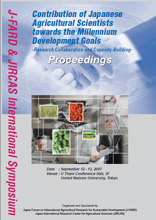How to increase the impact of agricultural research for development in Africa: the case of NERICA

We cannot fight against poverty and achieve food security in Africa without excellent research.
However, this does not mean that excellent research is enough to change Africa’s agricultural sector.
Research in Africa can have high impact only if we have (1) good technologies and (2) good infrastructure
and suitable environment thanks to political will.
A recent study conducted in West Africa by IFPRI (IFPRI 2006) concluded that among agricultural
commodities, rice showed the highest potential for growth and could subsequently generate the largest
producer benefi ts. The New Rice for Africa (NERICA), developed by WARDA with its partners, has been
confirmed as a revolution in rice research for Africa (Kijima et al. 2006), and the NERICA initiative has
received strong technical and fi nancial support from Japan.
Both upland and lowland NERICAs have won for WARDA several international and national
awards, including the 2006 United Nations South-South Triangular Partnership Award and the International
Koshihikari Prize.
According to the latest report from FAO (FAO 2007), the paddy production in Africa has gone up
for the 6th consecutive year, reaching 21.6 million tonnes in 2006 ? 6% above 2005. FAO attributed this
increase to good weather conditions and to the positive effect of NERICA adoption.
The NERICA rices have leapfrogged from West Africa to East Africa in Ethiopia, Kenya, and Tanzania.
Uganda has now about 36,000 ha under NERICA production within 5 years of its introduction in the country.
The NERICAs have also become the fi rst choice for agricultural rehabilitation efforts in post-confl ict areas in
DR Congo, Sierra Leone, Liberia, Rwanda, and Uganda.
Thanks to NERICA success, countries from Central and Eastern Africa want to join WARDA as
members. Existing member countries have also more confi dence in investing in rice research at WARDA.
WARDA is strengthening the rice research partnership through a programmatic alignment with IRRI
and CIAT to have a large-scale impact in Africa. WARDA scientists and their partners, particularly with
scientists from JICA and JIRCAS, are also addressing some major research gaps in NERICA, particularly
relating to agronomic aspects.
However, all these good news hide major constraints to rapid expansion of NERICA. One of the
biggest constraints is the lack of seed and the main reason for this is the lack of necessary resources of
national seed systems. The second biggest constraint is the lack of low-cost processing equipment. Postharvest
losses in SSA account for 15?50% of the market value of production.
In most African countries, the national agricultural extension systems are not suffi ciently developed.
The linkages between rice research, development, and policy are also weak. Extension services and operators
throughout the rice value chain lack the capacity to compete with their counterparts in Asia and Europe.
SSA production systems face competition from the government-subsidized sectors found in other
regions of the world. For example, USA’s 11,000 rice farmers receive subsidies worth $1.4 billion per year.
But Africa’s 36 million rice farmers struggle with no subsidies and little access to credit, inputs, markets,
and market information. Limited port and road facilities have raised the costs of delivering inputs to farmers, 47
and outputs to market. Fertilizer prices are 2 to 6 times greater in SSA than those in Asia, Europe, and North
America.
To overcome these constraints, the author recommends that every country should establish standard
seed laws, seed quality control mechanism for rice and should ensure their application. Seed legislation
should encourage the involvement of the private sector in seed supply and national programs should be
strengthened to produce breeder and foundation seeds.
Every country should also have local processing plants and post-harvest technologies to bring African
rice grain quality up to par with imported rice. Governments should reduce the import tax on low cost smallscale
machinery which can increase farmers’ labor effi ciency.
Every country should establish a rice stakeholders’ platform and create a fund to support the national
rice program. Governments should provide adequate funding to rice research and extension systems. The rice
sector in every country should be made competitive by improving the capacity and effi ciency of operators at
the research, extension, production, processing, and marketing levels.
It is vital for SSA governments to recognize urgently that African farmers, like all other farmers, need
support. Governments must supply fertilizers to farmers through support policies without killing the private
sector.
All these measures, combined with excellent research thanks to the strong technical and financial
support from donors like Japan, will lead to further increase in food security and prosperity in SSA and will
help African countries achieve the Millennium Development Goals.
| 刊行年月日 | |
|---|---|
| 作成者 | Papa Abdoulaye Seck |
| 著者キーワード |
Africa NERICA rice research policy |
| 公開者 | Japan International Research Center for Agricultural Sciences |
| オンライン掲載日 | |
| 号 | 2007 |
| 開始ページ | 46 |
| 終了ページ | 51 |
| 権利 | Japan International Research Center for Agricultural Sciences |
| 言語 | eng |
